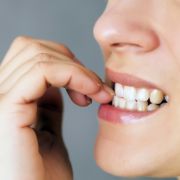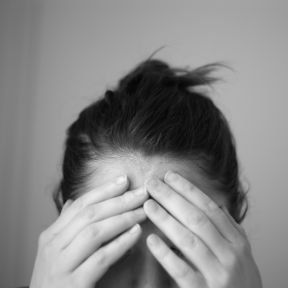
Body-Focused Repetitive Behaviors
Body-focused repetitive behaviors, or BFRBs, are a set of disorders categorized by self-grooming routines that essentially go awry. These include pulling, picking, biting, or scraping one's hair, skin, or nails. The disorders include trichotillomania (compulsive hair pulling), dermatillomania (compulsive skin picking, also called excoriation disorder), and onychophagia (compulsive nail biting). The prevalence of BFRBs is estimated to be at least 3 percent of the population, affecting both children and adults.

The question of why individuals engage in BFRBs, and how the disorders should be categorized, has long challenged psychologists. BFRBs have been theorized to be related to anxiety disorders, impulse control disorders, and obsessive compulsive disorder, but most experts agree that they differ significantly from all three. Certain BFRBs are currently categorized as “obsessive-compulsive and related disorders” in the DSM-5. Regardless of how the behaviors are categorized, they are difficult for individuals to control.
Individuals with BFRBs report different “triggers” for the behaviors. Many people pick or pull when they’re anxious, for instance—often finding that doing so provides temporary relief. But others report that they pick, pull, or scratch without noticing, or while engrossed in another activity like reading or watching TV.
BFRBs, by definition, are recurrent behaviors that persist despite repeated attempts to stop. Individuals with BFRBs often feel that their picking or pulling habits are out of their control. Treatment—and self-compassion—can help people reduce the frequency of the behaviors or stop them entirely.
Body-focused repetitive behaviors usually begin in late childhood or during the teen years. In rare cases, they may develop in adults or in younger children.
The disorders are thought to have a genetic component—and often run in families—and may also be influenced by early environment, stress, and temperament.
No; men develop BFRBs as well. However, the disorders do appear to be more common in women. About 90 percent of adults who seek help for BFRBs are female.
BFRBs can result in physical injury like scarring, skin infections, or bald spots. They frequently cause extreme emotional distress, particularly if the disorder is undiagnosed or kept secret. BFRBs, when severe, can impair someone's ability to socialize or to function at work.

Treatment recommendations for BFRBs include cognitive behavioral therapy, medication, and select supplements—most notably N-acetylcysteine, an amino acid. While for some, these options are highly effective, overall, they have a long-term success rate of less than 20 percent.
However, a precision medicine initiative recently launched by The TLC Foundation for Body-Focused Repetitive Behaviors is the largest effort yet to understand the neurobiology of BFRBs and find more effective treatments.
Find a therapist who specializes in body-focused repetitive behaviors.
CBT has been shown to help individuals with BFRBs identify triggers that cause picking or pulling. A specific form of behavioral therapy known as Habit Reversal Training may also be highly effective for recognizing behavior patterns and managing the negative emotions associated with BFRBs.
Medication is generally considered less effective than behavioral treatments at treating BFRBs. But some drugs have shown promise, particularly for individuals with co-occurring anxiety, depression, or OCD. These include selective serotonin reuptake inhibitors (SSRIs), clomipramine, naltrexone, and olanzapine.
Several self-help strategies have helped people with BFRBs manage the behaviors on their own. These include using an object to occupy the hands during times when pulling occurs; wearing gloves or mittens to make picking harder; and joining a support group to connect with others with BFRBs.

Although BFRBs affect millions, they are not well-understood and are rarely portrayed in the media. As a result, the behaviors are often seen as little more than “bad habits” that could be stopped using willpower.
Because of this misconception, many who live with BFRBs report debilitating shame surrounding the disorder. They may beat themselves up for their seeming inability to stop, or go to great lengths to hide the evidence of their hair pulling or skin picking—often using wigs or makeup, or refusing to let people see the parts of their body where they pick or pull. This intense shame can interfere with relationships, intimacy, and daily functioning.
Sharing feelings of guilt and shame with a loved one or therapist can be immensely helpful. Many with BFRBs also find comfort simply in learning that they are not alone. For this reason, support groups and online resources can be especially useful in reducing shame.
There is no cure for BFRBs; most who live with the disorders will need to manage and treat them for their entire lifetime. But improvement is possible, and many with BFRBs have developed treatment plans and coping mechanisms that have greatly reduced—or even eliminated—their need to pick or pull.
Sharing the disorder with friends or family can be an empowering experience, especially for those who have worked to hide the behaviors for years. Since BFRBs have genetic components, it’s possible that other family members have coped with them as well; such shared experiences may bring families closer.
The disorders have historically been poorly studied and widely misunderstood; fortunately, that has begun to change in recent years. Ultimately, a better understanding of the disorders' roots is critical for adequate treatment, especially because experts theorize that different subtypes may require different approaches.
Visiting a hair salon—and potentially exposing their disorder to someone who may not understand—can be emotionally draining for people with trichotillomania. Looking online to find a hairstylist who is comfortable with BFRBs can provide peace of mind and allow people with trich to look and feel their best.














